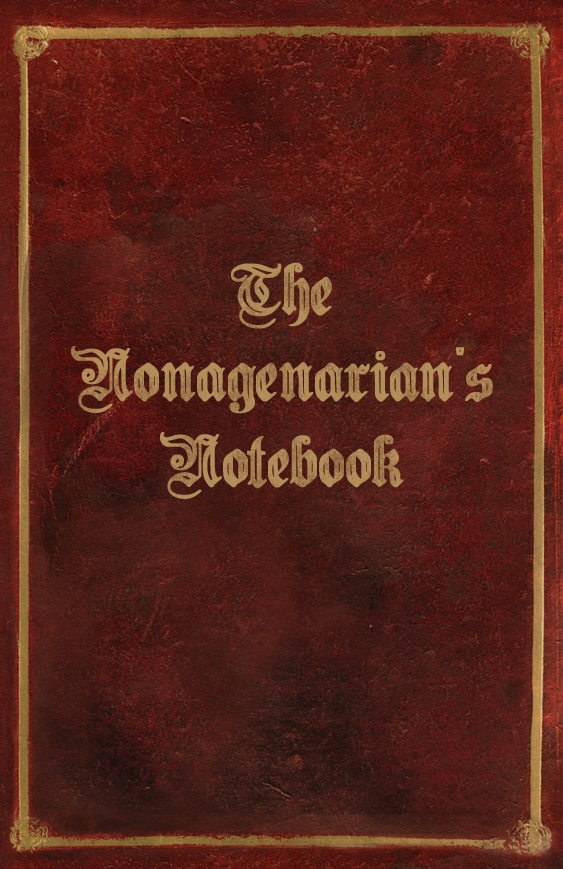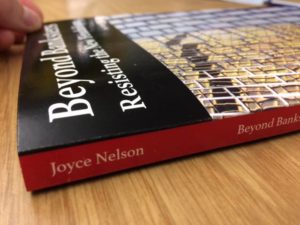A review of Beyond Banksters: Resisting the New Feudalism, by Joyce Nelson, Watershed Sentinel Books, 164 pages, $20.00
Over the course of my 70-plus years as a journalist, I’ve reviewed hundreds of books, many of them informative and educational. But Joyce Nelson’s Beyond Banksters, which I’ve just finished reading, is not only the most enlightening book I’ve ever wanted to review, but by far the most challenging.
It’s not that it’s difficult to read. Far from it. Joyce is renowned for both the clarity of her prose and for her meticulous research, both of which are on display in this, her latest blockbuster. The challenge it poses to a prospective reviewer is that its succinct 164 pages are jam-packed with vital facts, figures, insights and revelations. So many that it’s impossible to adequately summarize it in the normal 800 or 1,000-word book review.
To do justice to Beyond Banksters would require a separate review of each of its 16 chapters.
That problem hasn’t deterred previous reviewers, who have managed at least to define and praise its shocking revelations. Gordon Laxer calls it “a hard-hitting, well-researched, fast-paced exposure of the usually hidden world of Canadian and international banks.” Former federal cabinet minister Paul Hellyer says that “it sheds new light on what is really going on in the financial world.” John Stauber lauds Joyce for exposing “the hidden-in-plain-view takeover of Canada by a global élite and their banksters — a wakeup call that reads like a spy thriller. . . but is a reality that politicians and mainstream media spin and hide.” Joel Bakan, professor of law at UBC, says the book is “a powerful and chilling investigation into an emerging global oligarchy of banks and corporations. Written with wit and clarity, Beyond Banksters is not only informative, but a pleasure to read.” And Duncan Cameron, professor of political economy at Simon Fraser University, urges everyone concerned about corporate rule to “read Beyond Banksters and get your MP to read it.”
While I was reading it, I stuck post-it slips on the pages that contained sentences and paragraphs that particularly impressed me. On all the previous books I had to review, these sticky notes would number no more than a dozen, but in Beyond Banksters I wound up with 97 of them — and in only 164 pages. The book looked like a literary porcupine.
I could attempt to encapsulate all or most of these insightful references in a traditional review, but I think it would be better to just provide my readers with salient passages from some of the 16 chapters. Because of space limits, some of the excerpts are not in the same form or sequence as in the book, but they all factually reflect some of the highlights. So here goes:
Chapter 1
One of the most important legal cases in Canadian history is slowly inching its way towards trial. Launched by the Committee on Monetary and Economic Reform (COMER), the lawsuit would require the publicly-owned Bank of Canada to return to its pre-1974 practice of lending nearly interest-free money to federal, provincial, and (potentially) municipal governments for infrastructure and health care spending.Created during the Great Depression, the Bank of Canada funded a wide range of public infrastructure projects from 1938 to 1974, without our governments incurring debts to private lenders. Projects like the Trans-Canada Highway, the St. Lawrence Seaway, universities, hospitals, seaports and airports were all financed by interest-free loans from the Bank of Canada. In addition, universal medicare, old age pensions, and tuition-free postsecondary education were all made possible by Bank of Canada funding.
But in 1974. . . the Bank of Canada stopped lending to federal and provincial governments, forcing them to borrow from private (banks) and foreign lenders at compound interest rates – resulting in huge deficits and debts ever since.
Chapter 2
Unlike other developed countries in the G-7, Canada still has a publicly owned central bank. That is why COMER launched its lawsuit: it is still possible to return the Bank of Canada to its original mandate.The newly elected government of Justin Trudeau, however, seems intent on bypassing the COMER lawsuit by instituting an entirely different (partly private) bank for building infrastructure — one that will further indebt the country.
Chapter 3
In the globalized economy, giant investors expect to be able to pry open and seize the public assets of any country. . . Over the past two decades, and increasingly since 2008, big investors like Bank of America, JP Morgan Chase, Goldman Sachs, and Morgan Stanley have been buying up and gaining control over what’s known as “the real economy” — the already-built airports, seaports, roads, electricity production and transmission systems, water and wastewater systems, utilities, etc., across much of the developed world. These investments provide shareholders with increasingly long-term, steady profits from tolls and rents that previously went to the public owners of the infrastructure.As Web of Debt author Ellen Brown warned in 2013, such a trend represents “a return to the feudal landlord economy of unearned profits from rent-seeking.”
Chapter 4
Last August the Toronto Star reported that Justin Trudeau “spent part of the summer courting BlackRock, the world’s largest investment manager, a $5-billion juggernaut with headquarters in New York. Trudeau hopes some of that worldwide torrent of money can be diverted towards infrastructure projects in Canada.”Dominic Barton, who has become Canada’s “new Economy Czar,” has been appointed chair of the federal Advisory Council on Economic Growth. Barton is also the global managing director of consulting giant McKinsey & Co. His 14-member team on the Advisory Council includes Elyse Allan, vice-president of General Electric Canada; Brian Ferguson, president and CEO of Cenovus Energy Inc., and Christopher Ragan, research fellow of the C.D. Howe Institute.
Barton’s plans reportedly include “enticing huge investors from here and abroad to pour cash into major infrastructure projects” and “finding cash in places outside the public treasury and even beyond Canada’s borders.”
Chapter 7
The first years of the Great Recession can be characterized as a Great Race, with the banks and their supporters working mightily to spin the events on Wall Street in their own way, and others working just as feverishly to understand and explain what the hell had happened.This Great Race was a classic example of what Naomi Klein’s bestseller The Shock Doctrine had delineated: how “disaster capital” works during chaos to seize the advantage.
Then, in late September 2011, an independent market trader named Alessio Rastani appeared on the BBC and bluntly told the host of the show, “Governments don’t rule the world. Goldman Sachs rules the world. We traders don’t really care that much how they are going to fix the economy. Our job is to make money from it.”
Chapter 8
Although the federal debt had reached $581 billion by 2011, readers of the Globe and Mail were told on budget day that there were only three ways to reduce the debt: raise taxes, slash public programs, or sell off public assets. The possibility of borrowing from the government’s own Bank of Canada (as had been the practice prior to 1974) was overlooked once again.The loss of public memory has been brutal. As economist Michael Hudson recently recalled, “The private banks (since 1974) have had a huge lobbying power over governments.” That lobbying power apparently hasn’t diminished at all over the decades. The Justin Trudeau Liberals are now embracing trade deals like CETA and the TPP which, if ratified, will prevent banking and monetary reform — not just in Canada, but across the planet.
Chapter 10
The Canada-EU trade deal (CETA) will allow for dozens more corporate lawsuits to be filed each year against the Canadian government under its draconian investor-state dispute settlement mechanism. The ISDS — first introduced in NAFTA — allows foreign multinational corporations to sue elected governments for laws or policies that they feel would decrease their future profits.As of January 201 5, there had been 37 known ISDS claims against Canada under NAFTA, with settled awards to corporations amounting to about US$341 million. An additional $65 million was spent in court costs and legal fees, and the federal government still faces over $2.6 billion in pending claims.
5, there had been 37 known ISDS claims against Canada under NAFTA, with settled awards to corporations amounting to about US$341 million. An additional $65 million was spent in court costs and legal fees, and the federal government still faces over $2.6 billion in pending claims.
CETA is an even worse deal because it prevents Canadian provinces and municipalities from favouring local contractors. So European companies will be allowed to bid for federal, provincial, and municipal procurement contracts worth more than $100 billion a year — and could sue any government they think has discriminated against them. Legal experts predict that lawsuits over lost contracts will mushroom in Canada.
Chapter 14
Back in 2009, the Liberal Dalton McGuinty government of Ontario paid Goldman Sachs and CIBC World Markets $200,000 to assess the value of the province’s Crown assets, including Hydro One’s 150,000 kilometres of transmission lines — one of the largest electricity transmission lines in North America.The first IPO shares sell-off of Hydro One in November 2015 was handled by a banking syndicate that included RBC, Scotiabank, TD Bank, Goldman Sachs, Barclays, and Credit Suisse Securities. Collectively, they made more than $29 million handling that sale. A second offering of 72.4 million Hydro One shares was conducted by the same bankers in April 2016, upping their take to nearly $60 million for the partial privatization.
Chapter 15
Praising the Trudeau Liberals for their support of the Trans-Pacific Partnership, Scotiabank CEO Brian Porter cautioned that infrastructure projects undertaken should be those that will create jobs. One such project he favoured was the $16 billion Energy East pipeline that would transport tar sands diluted bitumen (dilbit) from Alberta to New Brunswick, where it would be exported to refineries in the U.S. and potentially Europe. He claimed it would create “tens of thousands of jobs” and generate billions in tax revenues.More than 70% of tar sands companies, however, are foreign-owned, as are all the offshore refineries. And, as for those “tens of thousands of jobs,” the vast majority promised, according to the Council of Canadians, “would be short-term, in construction and secondary industries,” while a pipeline spill from Energy East would be a major “job killer.” The pipeline would actually “cross more than 900 waterways that are used for drinking, fishing, recreation, and sustaining farmland.”
Most Canadians might be surprised to learn that the Canadian Pension Plan Investment Board has been putting vast amounts of their CPP contributions into tar sands companies. The CCPIB has invested $286 million in TransCanada Corp., $357 million in Enbridge, $294 million in Canadian Natural Resources Ltd., $268 million in Suncor, $86 million in Cenovus, and $34 million in Imperial Oil. More than a dozen foreign oil companies also receive CCPIB investments amounting to about $700 million, including Chevron ($111 million, ExxonMobil ($103 million), and Royal Dutch Shell ($30 million).
Chapter 16
When the banks in Iceland collapsed and its economy went belly up in October 2008, “the Icelanders were in no mood to take a post-meltdown prescription from the same sources that had sickened them in the first place,” Geoff Olson of Common Grounds reported. “They nationalized one bank, put three others into receivership, and instituted capital controls.” Over the next seven years, they put 26 banksters behind bars, serving terms of two to five years, for crimes including market manipulation, embezzlement, and breach of fiduciary duties.”Icelanders took to the streets in 2008, banging pots and pans, chanting “Bailouts no! Jail-ins yes!” They refused to pay for the crimes and corruption of the bankers through tax increases and social program cuts. Instead, they insisted on the arrest and prosecution of dozens of bankers responsible for the financial collapse, forced their entire government to resign, and created a citizens’ committee tasked with writing a new constitution protecting the country from corporate greed — all the while actually expanding their social safety services.
This is what should have happened in Canada and every other country devastated by voracious and irresponsible international banks and investment companies. One of the reasons it didn’t, apart from civil passivity, is that the story of the Icelanders’ revolt against their financial overlords went virtually unreported in the mainstream media. Most people outside Iceland didn’t get to learn about it, except through the social media.
*
This review, although rather longer than usual, should not be considered a substitute for reading the entire contents of the book. It contains a plethora of salient facts, figures, and analysis that I doubt more than one in ten Canadians has seen before. I don’t often refer to a book as an urgently “must-read,” but this one definitely fits that description.To be fully informed about “the new feudalism” and how to resist it, Beyond the Banksters is an indispensable source of knowledge. As the publishers put it on the back-cover, “From Milton Friedman to Justin Trudeau’s Canada Infrastructure Bank, from Blackrock to crappy trade deals to Bilderberg, Nelson exposes the major players privatizing the world and creating a new state of feudalism. Iceland resisted, and so can we.”
Beyond the Banksters can be ordered directly from Watershed Sentinel Books: www.watershedsentinel.ca/banksters
Ed Finn was Senior Editor at the CCPA and editor of the CCPA Monitor from 1994-2014. Formerly, as a journalist, he worked at The Montreal Gazette and for 14 years wrote a column on labour relations for The Toronto Star. He also served for three decades as a communications officer for several labour organizations, including the Canadian Labour Congress and the Canadian Union of Public Employees. And yes, Ed is a true nonagenarian, having celebrated his 90th birthday last year. Stay tuned for more passages from The Nonagenarian’s Notebook.







